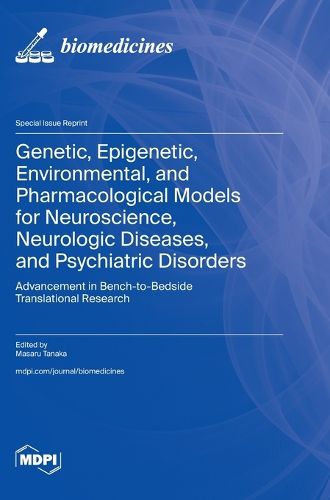Readings Newsletter
Become a Readings Member to make your shopping experience even easier.
Sign in or sign up for free!
You’re not far away from qualifying for FREE standard shipping within Australia
You’ve qualified for FREE standard shipping within Australia
The cart is loading…






This title is printed to order. This book may have been self-published. If so, we cannot guarantee the quality of the content. In the main most books will have gone through the editing process however some may not. We therefore suggest that you be aware of this before ordering this book. If in doubt check either the author or publisher’s details as we are unable to accept any returns unless they are faulty. Please contact us if you have any questions.
The Special Issue, "Genetic, Epigenetic, Environmental, and Pharmacological Models for Neuroscience, Neurologic Diseases, and Psychiatric Disorders: Advancement in Bench-to-Bedside Translational Research," delves into the complexities of neurological and psychiatric disorders, which affect millions worldwide. Despite advances, the etiology and pathogenesis of these disorders remain largely unknown, and current treatments often fall short or have adverse effects. This issue emphasizes the urgent need for new strategies to prevent, diagnose, and treat these disorders. It underscores the importance of establishing reliable models that can recapitulate the complex interactions between genetic, epigenetic, environmental, and pharmacological factors contributing to these disorders. The issue presents 12 articles covering a wide range of topics and methods in neuroscience and neurology, highlighting the potential of novel interventions that can modulate the molecular and functional alterations underlying these disorders. It aims to stimulate further research and collaboration among researchers and clinicians, inspire new ideas and innovations, and ultimately benefit patients and society. Readers can explore the diverse and exciting topics presented in this collection. We extend our gratitude to all authors and reviewers for their contributions to this Special Issue.
$9.00 standard shipping within Australia
FREE standard shipping within Australia for orders over $100.00
Express & International shipping calculated at checkout
This title is printed to order. This book may have been self-published. If so, we cannot guarantee the quality of the content. In the main most books will have gone through the editing process however some may not. We therefore suggest that you be aware of this before ordering this book. If in doubt check either the author or publisher’s details as we are unable to accept any returns unless they are faulty. Please contact us if you have any questions.
The Special Issue, "Genetic, Epigenetic, Environmental, and Pharmacological Models for Neuroscience, Neurologic Diseases, and Psychiatric Disorders: Advancement in Bench-to-Bedside Translational Research," delves into the complexities of neurological and psychiatric disorders, which affect millions worldwide. Despite advances, the etiology and pathogenesis of these disorders remain largely unknown, and current treatments often fall short or have adverse effects. This issue emphasizes the urgent need for new strategies to prevent, diagnose, and treat these disorders. It underscores the importance of establishing reliable models that can recapitulate the complex interactions between genetic, epigenetic, environmental, and pharmacological factors contributing to these disorders. The issue presents 12 articles covering a wide range of topics and methods in neuroscience and neurology, highlighting the potential of novel interventions that can modulate the molecular and functional alterations underlying these disorders. It aims to stimulate further research and collaboration among researchers and clinicians, inspire new ideas and innovations, and ultimately benefit patients and society. Readers can explore the diverse and exciting topics presented in this collection. We extend our gratitude to all authors and reviewers for their contributions to this Special Issue.